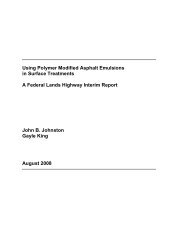Handbook for Bridge Inspections - TSP2
Handbook for Bridge Inspections - TSP2
Handbook for Bridge Inspections - TSP2
You also want an ePaper? Increase the reach of your titles
YUMPU automatically turns print PDFs into web optimized ePapers that Google loves.
• Damage to slope protection<br />
• Damage to piles above water<br />
• Damage to pennanent sheet piling above water<br />
• Un planned removal or deposition offill material in the vicinity<br />
of foundations<br />
• Accumulation of waste etc. restricting the water flow<br />
• Excessive vegetation, trees etc.<br />
• Accumulation of combustible materials underneath bridges.<br />
Concrete Elements<br />
Steel Ele me nts<br />
• Settlement or movement of abutments, supports, superstructures<br />
etc.<br />
• De<strong>for</strong>mation of superstructure or other element due to differenti<br />
al settlement, excessive load or defomlation of scaffolding<br />
during construction.<br />
• Cracks and possible leakage through these. (It should be eonsi<br />
dered to register crack-widths and crack patterns). Special con<br />
sideration should be given to check anchorage zones of prest res<br />
si ng cables <strong>for</strong> cracks.<br />
* Defect to surface treatment<br />
• Discoloration of concrete surfaces due to leakage or graffiti.<br />
• Reduced or damaged concrete cover with possible future corro<br />
sion damage in mind (carbonisation, ch lorides, binding wire,<br />
di stance holders etc.)<br />
• Disintegration due to frost or weathering<br />
• Pouring defects or areas with obviously bad workmanship, areas<br />
with possible penetration of mo isture, pores in the surface etc.<br />
• Lack of adhesion and/or spalling of structural concrete, integral<br />
ly cast concrete, repaired areas, casting joints, prestressing anc<br />
horages, etc.<br />
• Spall ing, failure or other damage due to coll ision<br />
* Visible rein<strong>for</strong>cement bars or spall ing due to corrosion or woo<br />
den pieces cast into the concrete etc.<br />
• Obvious rein<strong>for</strong>cement corrosion or signs of ongoing corrosion<br />
processes shown by cracking along the outermost rein<strong>for</strong>cement<br />
bars or rust staining.<br />
* Satisfactory concreting around prestressing cable anchorages<br />
• Excessive vegetation, trees etc.<br />
• Scaffolding or ties left in place, etc<br />
• The general state of cleaning o f the considered element.<br />
• De<strong>for</strong>mation of superstructure or other elements due to differen<br />
tia l settlement of foundations, excessive load or col lision.<br />
• Relative movements of superstructure or other elements<br />
• Cracks or fa il ure in base material, welds, bolts or rivets<br />
• Defects in corrosion protection system (paint, galvanising, coa<br />
ting) and possible corrosion. The connection area between cone<br />
rete and steel is especially vulnerable. The same appli es to the<br />
upper flanges supporting wooden roadways.<br />
• Discoloration due to leakage or graffiti<br />
<strong>Handbook</strong> <strong>for</strong> <strong>Bridge</strong> <strong>Inspections</strong> 69
















